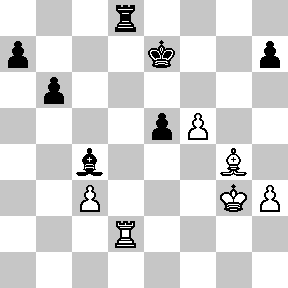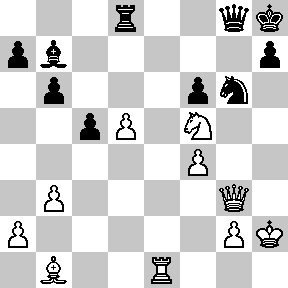
Sports Archives — The Altamont Enterprise, April 5, 2012
Last Week

Howard – Henner, Albany Club championship 2012
White to move and win
Chess Solution
40 f6+ Ke8
41 Bh5+ Bf7
42 B:f7 K:f7
43 R:d8
This Week

Nimzowitsch – Von Gottschall, Breslau 1925 (analysis)
White to move and win in 10 moves
Chess Solution
27. Ne7 N:e7 28 R:e7 (threatening R:h7+) Q:g3 29. K:g3
Rg8+ 30. Kf2 Rg7 31. d6 R:e7 32. de Bc6 33. Be4 Be8 34. f5
Rg7 35. Bd5 (Black can not attack the e7 pawn) Kh6 36. Kf3
Kg5 37. Ke4 and White will play Kd5 and Bc6 forcing the
win of the Bishop to stop the pawn from queening.
Battle between teenage grand masters decides Reykjavík Open
By Peter Henner
Fabiano Caruana, who is 19, won the 2012 Reykjavík Open with a score of 7.5 out of 9, by holding 18-year-old Women's World Champion Yifan Hou to a draw in their last-round encounter.
GM Hou finished in a tie for second through eighth with a score of 7 points.
Going into the last round, Caruana led with 7 and was paired against Hou with a score of 6.5. If Hou had won, she would have finished first with 7.5.
Hou obtained what should have been a winning advantage, but made a few mistakes in severe time pressure, and eventually blundered away the win.
The Reykjavík Open has been sponsored by the city of Reykjavík since 1964 as part of an annual chess festival. This year, the tournament drew 203 players from 33 countries, including 27 Grandmasters and 19 International Masters.
Six Americans competed, including Grandmaster Robert Hess (6.5), IM Irina Krush (6.0), IM Mark Arnold (6.0), FIDE Master (“FM”) Keaton Kiewra (6.0), GM Yuri Shulman (6.0), IM John Bartholomew (5.5), and FM Teddy Coleman (5.5).
Fabiano Caruana
Caruana is a genuine chess prodigy: the youngest Grandmaster in the history of both Italy and the United States, having achieved the title at the age of 14 years, 11 months, and 20 days.
He was born in Miami and moved to Brooklyn at the age of 4 where his chess talent was discovered. He was originally coached by renowned chess coach Bruce Pandolfini (featured in the movie Searching for Bobby Fischer).
When he was 12, his family relocated to Madrid, and three years later to Budapest, to provide him with better opportunities to train and follow a professional chess career.
Caruana now lives in Switzerland, and plays for Italy, even though he has dual citizenship in both the United States and Italy.
As a result of his victory in this tournament, he is now ranked sixth in the world (passing the top-rated American, Hikaru Nakamura).
Time-pressure blunders
Last week, I described how I lost the Albany Championship by making a time pressure mistake in a won position.
These mistakes are not limited to club players; GM Hou, with a chance to win the Reykjavík Open, also blundered in time pressure. Although the blunder cost only ? a point, it still deprived her of the championship.
Had she won, it would have been her second stunning triumph this year, following her tie for first in the Gibraltar Chess Festival (see Enterprise article from Feb. 15, 2012).
The game followed a well known line of the Ruy Lopez, and was basically even for the first 30 moves. A bad 31st move played by Caruana enabled Hou to obtain a strong advantage.
Hou – Caruana
Reykjavík Open 2012
1. e4 e5 2. Nf3 Nc6 3. Bb5 a6 4. Ba4 Nf6 5. O-O b5 6. Bb3 Bc5 7. c3 d6
8. d4 Bb6 9. h3 O-O 10. Be3 h6 11. Nbd2 Re8 12. Re1 Bd7 13. Qb1 Na5
14. Bc2 c5 15. d5 c4 16. b4 c:b3 17. a:b3 B:e3 18. R:e3 Nb7 19. b4 Nh5
20. Bd3 Nf4 21. Bf1 Rf8 22. c4 b:c4 23. B:c4 a5 24. b:a5 N:a5 25. Qb4 N:c4
26. R:a8 Q:a8 27. N:c4 Qa1+ 28. Re1 Qa2 29. Nfd2 Rc8 30. Re3 Qc2
31. Kh2 Nd3 (This mistake permits White to launch a strong attack. 31…Qd1 threatening Nc2 and Qb1 was needed.)
32. Qb7 Nc5 (Q:d6 leads to uncertain but interesting complications)
33. Qb6 Nd3 34. N:d6 Rf8 35. N6c4 N:f2 (Moving the other Knight Nc2c4 was stronger. However, Black is still close to a resignable position.)
36. Qb1 Q:b1 (White’s position is overwhelming and there is a strong temptation to simplify the position to avoid complication in time pressure. However, the exchange of Queens reduces White’s advantage.)
37. N:b1 Bb5 38. Nba3 Ba6 39. N:e5 Re8 40. d6 Bb7 (40…Rd5 loses to 41 e7)
41. N:f7 K:f7 (The time control was reached at move 40 and White needed to take a break and catch her breath before continuing to play at top speed. It is not unusual for players, even world class players, to keep playing fast and make fatal blunders even though they are allowed time to relax after making the time control. 41. Nac4 wins, e.g. 41…N:e4 42. d7 Rd8 43.Na5 Bd5 44. Rd3 Nf6 45. R:d5 46. Nb7. Now the position peters out to a dead draw.)
42. Rf3+ Ke6 43. Nb5 Rb8 44. R:f2 B:e4 45. Re2 R:b5 46. R:e4+ K:d6
47. Kg3 Kd5 ?-?
Last week’s easy problem
Due to a technical issue with the diagram, last week’s problem, the conclusion of the decisive game of the Albany Championship where I lost to Dean Howard, was omitted.
I have just moved my rook to challenge for control of the d file, thinking that the exchange of rooks is forced and my extra passed pawn will give me an easy win. However, 39… Rd8 was a fatal blunder. How did Dean Howard take advantage of it?
This week’s difficult problem
The position appears equal, but White has a forced win in 10 moves. Can you find it?